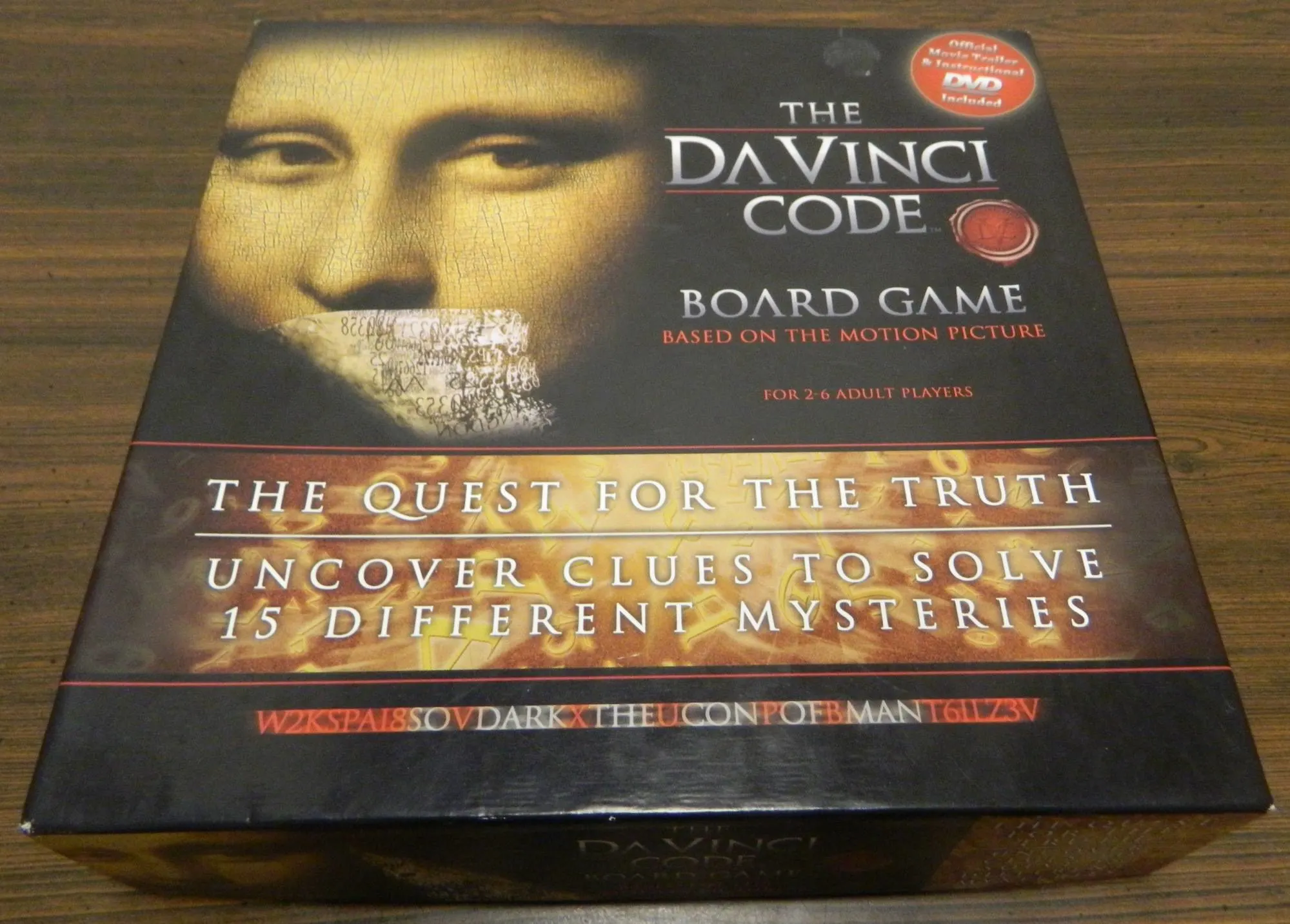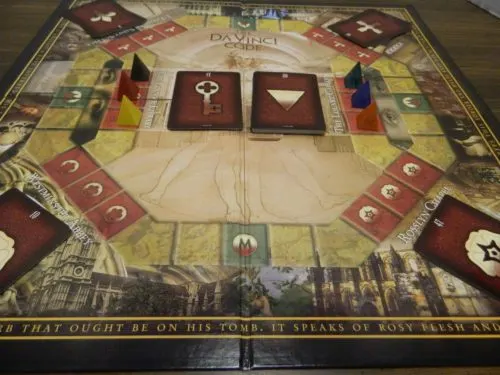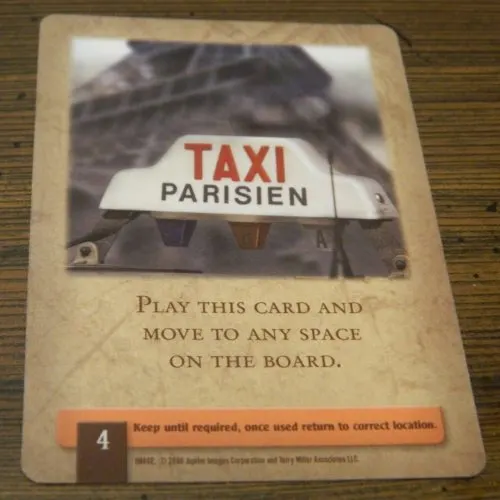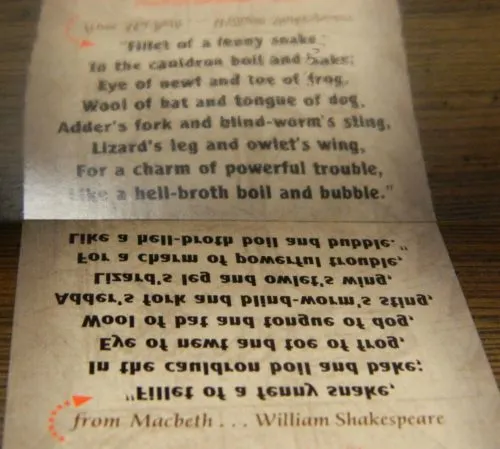Originally created in 2003 by Dan Brown, the Da Vinci Code was huge in the 2000s. With how popular the book and movie were when they were released, it lead to a lot of different merchandise being created which included a couple board games. With the track record of movie tie-in board games I can’t say that I had high expectations for The Da Vinci Code Board Game. Usually movie tie-in games are created as quick money grabs where little effort is put into trying to make it a good game. For a movie tie-in game The Da Vinci Code Board Game actually has some interesting mechanics that could have lead to a good game if it was designed a little better.
How to Play The Da Vinci Code Board Game
Setup
- Place the gameboard in the middle of the table. Place the decoding tools to the side of the gameboard.
- Each player takes an answer sheet and a pen/pencil. Fold down the top of the sheet so other players can’t see the mystery phrase spaces that you have filled in.
- The player fills in the depository code section of the sheet with three different numbers between one and six.
- Choose a mystery to play and take the corresponding cards from the box.
- Mystery One: 50-59
- Mystery Two: 60-69
- Mystery Three: 70-79
- Mystery Four: 80-89
- Mystery Five: 90-99
- Mystery Six: 100-109
- Mystery Seven: 110-119
- Mystery Eight: 120-129
- Mystery Nine: 130-139
- Mystery Ten: 140-149
- Mystery Eleven: 150-159
- Mystery Twelve: 160-169
- Mystery Thirteen: 170-179
- Mystery Fourteen: 180-189
- Mystery Fifteen: 190-199
- Separate the clue cards based on the symbols on the back of the cards. Next take taxi cards and depository cards based on the number of players. If there are 2-4 players use four taxi and depository cards. If there are 5-6 players you will use all six taxi and depository cards. Shuffle each set of symbol cards and place them on the corresponding spots on the gameboard.
- Shuffle the code-breaking cards and place them face down in the Louvre Library. Shuffle the art cards and place them face down in the Louvre Gallery.
- Each player chooses a playing piece and places it on one of the six spaces next to the Louvre.
- The oldest and wisest player starts the game.
Playing the Game
A player begins their turn by rolling the die. They will move their playing piece the corresponding number of spaces. They can move their playing piece in any direction but they can’t change directions during a turn. If a player lands on a metro (M) space they can move to any other metro space and continue moving if they still have spaces remaining.
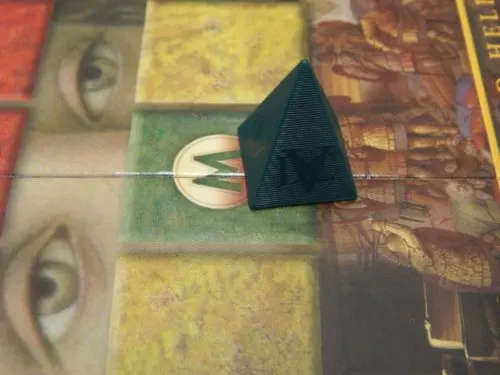
The green player has landed on a metro space so they can move to any other metro space. If they still have movement spaces remaining they can continue moving.
When a player lands on one of the spaces in front of one of the landmarks they will draw the top card from the corresponding pile. The four corner landmarks will give players clue cards. When a player draws a clue card they will be able to look at it and take notes until their next turn or when another player lands at the same location. The clue card is then placed on the bottom of the corresponding pile.
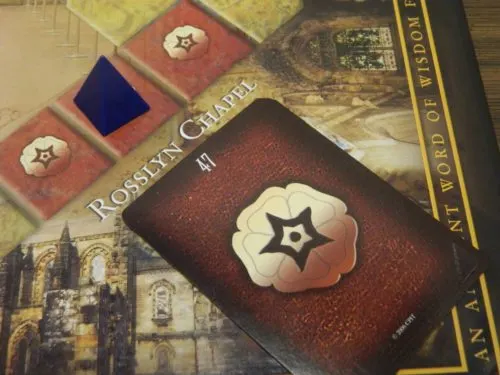
The blue player has landed on one of the spaces in front of the Rosslyn Chapel. They will get to look at the top clue card in this pile.
In the middle of the gameboard the two Louvre landmarks give players information they need in order to solve some of the clue cards. The sand timer is flipped over and the player has that much time to look through all of the corresponding cards looking for the information they need.
When a player draws a taxi card they keep it in their hand. Instead of rolling the die they can use the taxi card to move to any space on the gameboard. Once the card is used it is returned to the bottom of the corresponding pile.
Just like with the taxi cards, a player can keep a depository card when they draw it. When a player plays a depository card they choose a player and roll the die. If the number they roll is in the chosen player’s depository code, you get to look at that player’s notes. You cannot look at the player’s mystery phrase area. If the number rolled is not in the player’s depository code, the player doesn’t get to take a special action. After the card is used it is returned to the corresponding pile.
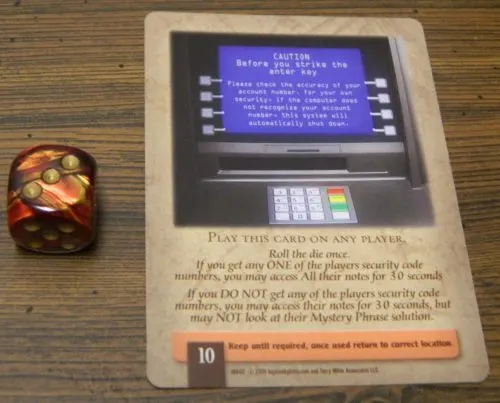
This player has played a depository card. They will choose a player and then roll the die. If the chosen player has a three in their depository code, the player gets to look at the notes section of their answer sheet.
Clue Cards
There are a couple different types of clue cards in the game. Some of the clue cards will feature numbers along the top of the card. These numbers correspond to spaces of the mystery phrase. By solving the clue card you will discover the letters/spaces for the corresponding spots of the mystery phrase. The clue card could be solved by looking at one of the other clue cards or by looking through the code-breaking cards in the Louvre Library or the art cards in the Louvre Gallery.
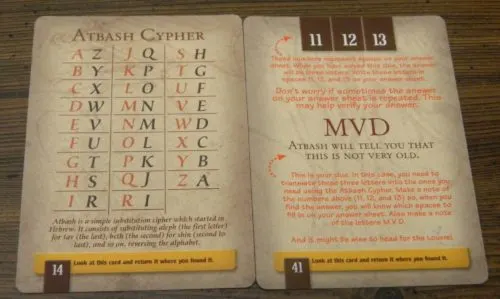
The clue card on the right gives you the letters “MVD” and tells you to use the Atbash Cypher. When the player reaches the library they can look at the Atbash Cypher which gives them the answer “NEW” which corresponds to spaces 11, 12 and 13 of the secret message.
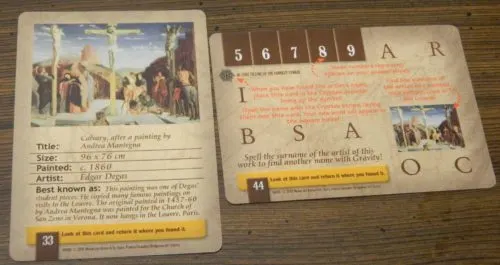
In order to solve the clue card on the right the player has to reference the gallery to find the last name of the painter who painted the picture shown on the card. The keyword for this card is Degas.
When a player solves a clue they fill in the corresponding spaces in the mystery phrase of their answer sheet.
Some of the clue cards require you to use one of the decoding tools.
Mirror Decoder: When you draw a clue card with the text printed backwards, you need to grab the mirror in order to flip the text so you can read it properly.
Sidebar Decoder: These cards feature letters along the left side of the card. First you need to solve for the card’s keyword. Then align the colored arrow from the card with the corresponding arrow on the decoder. Then look up the letters from the keyword to get the corresponding letters for the mystery phrase.
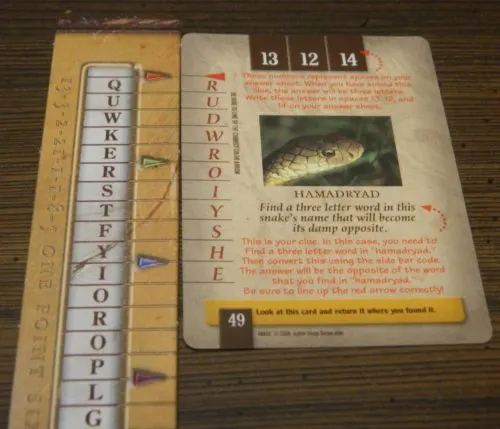
For this card the keyword is DRY. The card is placed next to the sidebar decoder. The player looks up the word DRY which ends up becoming the word WET.
Cryptex Decoder: These cards feature letters throughout the card. Players first need to solve the card’s keyword. The player then finds the corresponding cryptex strips to spell out the keyword. The card is place on the cryptex decoder with the marker on the card matching the marker on the decoder. The strips are then placed on top of the card spelling out the keyword. This will cover up most of the letters on the card revealing the letters that are part of the mystery phrase.
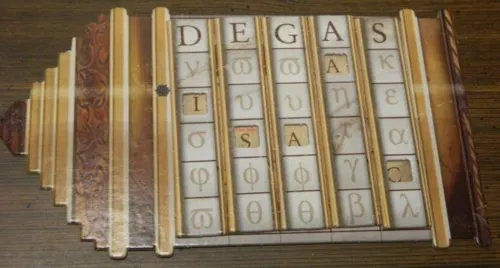
The keyword for this card was Degas. The player places the card on the decoder and places the strips on the card to spell out Degas. This reveals the secret word Isaac which are the secret message letters from this card.
Winning the Game
When a player thinks they have solved the mystery phrase they can head to one of the six spaces next to the Louvre. They will then announce their solution and check if it is correct in the instructions. If they are correct the main portion of the game ends. Each player will score one point for each letter/blank that they got correct. The player who solved the phrase will also receive an additional five points.
The player who solved the phrase will then take the instructions and read out the five questions for the mystery. All of the players write down their answers on their answer sheet. Once all of the questions have been asked the players look at the answers. Each player will score five points for each correct answer. If a player gets all five answers correct they will receive an additional five points.
Player will then lose five points for each taxi and depository card that they still have in their hand.
Each player adds up their points. The player with the most points wins the game.
My Thoughts on The Da Vinci Code Board Game
As I already mentioned I didn’t have high expectations of The Da Vinci Code Board Game before I started playing it. While I actually thought The Da Vinci Code had the potential to be a good board game, I thought it was going to be another rushed board game made to try and cash in on a hot property. Usually movie tie-in games take a generic board game, slap on the movie’s theme and maybe alter a couple mechanics. They generally aren’t known for new or unique mechanics. After reading through the rules (which are a mess by the way) my expectations for the game picked up a little as it actually looked like the game tried to do something new.
While the game still relies on a roll and move mechanic which is not very good (more on this later), the designers actually put some effort into designing The Da Vinci Code Board Game. They wisely figured that a majority of the game should deal with solving puzzles/mysteries since that is the premise of the book/movie. While the puzzles can be a little hit or miss, I give the game credit for how they choose to implement the puzzles into the gameplay.
Basically the game is divided into fifteen different mysteries. You choose one of the mysteries to play and then use the ten corresponding clue cards. For each mystery there is a mystery phrase that you have to solve. In order to solve the mystery phrase you need to move around the board checking out all of the different clue cards. Most of the clue cards feature numbers on them which correspond to different letters in the mystery phrase. In order to uncover the mystery phrase you have to solve the clue cards in order to get the letters of the phrase. I actually think this is pretty clever as it finds a way to add quite a few little puzzles into a more traditional board game.
In general I liked the little mysteries on the clue cards. The difficulty of the mysteries can vary quite a bit but I thought the variety of clues you had to solve was refreshing. You can solve some of the mysteries using your own logic. Other cards force you to have prior knowledge of the card’s topic in order to solve the puzzle. This would have lead to the game becoming an art/history trivia game except that the designers were pretty clever in finding a way to give players the required knowledge while also tying in the game’s theme. The game includes a library and gallery which includes cards with the information needed to solve these puzzles. Players can visit the locations which gives them a limited amount of time to look at the cards for the information they need. While I think the game should have given you a little more time with the cards, I actually really like the mechanic as it is pretty clever. If you already know a lot about art/history it will also give you an advantage in the game.
The other clue cards in the game have you using one of the decoders to solve for the card’s letters. Due to the instructions being terribly written at first these mechanics might not make a lot of sense. Once you get a hang of them though they are simple enough to use. While the mirror puzzles kind of feel like a waste, I actually liked the other two quite a bit. They force you to solve for a keyword which you then use with the decoder in order to find the card’s letters.
Not surprisingly the puzzle mechanics are by far the best part of The Da Vinci Code Board Game. While I am guessing that the different types of puzzles are reused in the other mysteries, it is refreshing that there is variety in the puzzles. The different types of puzzles kind of make it feel like you are solving mysteries alongside Robert Langdon. I actually think the design of the puzzles could have made for a good board game. In some ways The Da Vinci Code Board Game feels like it was trying to be a designer board game.
The problem is that the game doesn’t go far enough in this direction. Outside of the puzzle mechanics the game feels like your typical mass market board game. The game relies heavily on the roll and move mechanic. You roll the die which determines how far you can move on your turn. Since you have to land on the landmarks by exact count, the players who roll the best are going to have a significant advantage in the game. If you roll poorly you are going to have a hard time winning the game.
While I liked the idea behind the mystery phrase, it doesn’t work as well in execution as I was hoping. The problem is that the mystery phrases are too easy to solve with only a fraction of the letters. After having only filled in around seven of the twenty spaces I was able to solve the entire phrase. At this point I could have just ended the game without ever seeing around half of the clue cards. The only reason I held off solving the phrase right away is to get more of the clues to help me with the question part of the game. Unfortunately I don’t know how the game could have really fixed this mechanic which is a shame since it does take something away from the game as a whole.
Speaking of the questions there are things that I liked and disliked about them. I liked the idea of the game testing the knowledge you gained during the mystery but I think the game takes it a little too far. One to three of the questions are pretty easy if you were paying attention while going through the clue cards. The remaining questions are pretty difficult though. Basically the only way you can answer these questions correctly is when searching through the gallery/library you write down everything about the cards you look at. These questions have to deal with specific years and facts which you will only get right if you already knew the answer or wrote it down while looking through the library and gallery. As the questions don’t add a whole lot to the game, I wonder if the game would have been better if they weren’t included at all.
Another issue that I had with The Da Vinci Code Board Game is that the game decided to not to include a minimum time limit to look at a clue card. Basically you only have until your next turn or when another player needs the card. While this will sometimes be enough time, there are a lot of times where you don’t get enough time so you have to look at the card again. The problem is that players can take their turns quickly so you might have less than 30 seconds to look at the card before you have to put it back. That is not enough time in my opinion. While I appreciate that the game keeps the gameplay moving so players don’t have to sit around waiting as other players read cards, at times it pushes it too far. I honestly think I would add a house rule that if a player is still looking at a clue card when it is their turn again, the sand timer is flipped over and the player has 30 seconds to finish looking at the card. This will make it so all of the players will at least get some time to look at their card.
As far as the taxi and depository cards are concerned, for the most part I think they are a waste of time. I like that the taxi cards can be used to take you to any spot on the gameboard which helps reduce some of the die roll luck. The problem is players generally would prefer to look at the next clue card instead of taking a taxi card. The depository cards are worse as I don’t think they are particularly useful. The only use they could have is looking at the clues that another player has written down. Since you can’t look at their mystery phrase and players know you may at any time look at their clues, they likely will leave cryptic clues that aren’t going to really help you. On top of that the cards are worth negative points if you don’t use them so towards the end of the game you are forced to waste turns playing them in order to avoid the negative points.
While on the topic of the cards I think the rule where you have to take the top card from a pile is pretty stupid. The problem with this rule is that players will either have to draw cards that they have already seen (likely knowing that they have already seen it) or they have to wait around for other players to take the cards on top of the card they need. I think the game would have been better if they allowed players to choose which card they wanted from each pile so players could avoid drawing repeat cards unless they wanted to. Letting players choose which card they wanted to see would have shortened the game while also removing some of the luck.
In some ways there are things that I liked and didn’t like about the game’s components. As I already mentioned the game’s instructions are a mess. The instructions are so bad that the game includes a DVD explaining how to play the game. I didn’t watch the DVD since I eventually figured out the instructions. The artwork and the design of the components is pretty good. The quality of the components is also not bad for this type of game. The text on some of the cards is really small though where players with bad eyesight may need to use a magnifying glass in order to read the cards.
The biggest problem with the components is the fact that the game only includes cards for fifteen mysteries. While this is more than a lot of these type of games include, once you have played all fifteen mysteries there isn’t much else to do with the game. Once you know the solutions to the mysteries there is no reason to play them again. Unless you want to wait long enough that all of the players forget the solutions, you can only play the game fifteen times.
Should You Buy The Da Vinci Code Board Game?
While The Da Vinci Code Board Game had some potential due to the puzzles, there are too many other problems with the game that prevent it from being as good as it could have been. I give the designers credit for actually including some interesting puzzle solving mechanics into the game. There is good variety in the puzzles and they do a good job implementing the theme. I actually think the puzzle solving mechanics could have made for a good game. The problem is that the rest of the game relies on more traditional board game mechanics. The roll and move mechanics add a lot of luck to the game. The mystery phrases are too easy to solve without getting all of the clues and the questions at the end of the game ask for too specific of information. The game doesn’t even give you enough time to look at some of the cards. The biggest problem though may be that there are only fifteen mysteries to solve. Once you have played all of the mysteries, you either have to wait to forget the solutions or you can only play the game fifteen times. The Da Vinci Code Board Game has some interesting ideas but there are flaws keeping it from being as good as it could have been.
If you aren’t really into puzzle games I don’t think you will like The Da Vinci Code Board Game. If you like puzzle games though there are things to like about the game. Due to the game’s problems though I would only consider purchasing the game if you can get a good deal on it.
If you would like to purchase The Da Vinci Code Board Game you can find it online: Amazon, eBay

